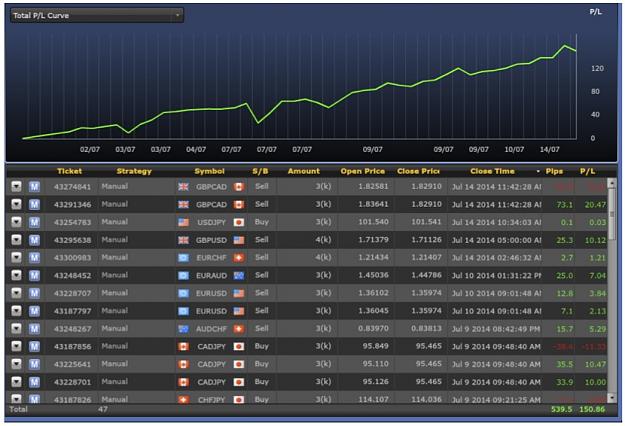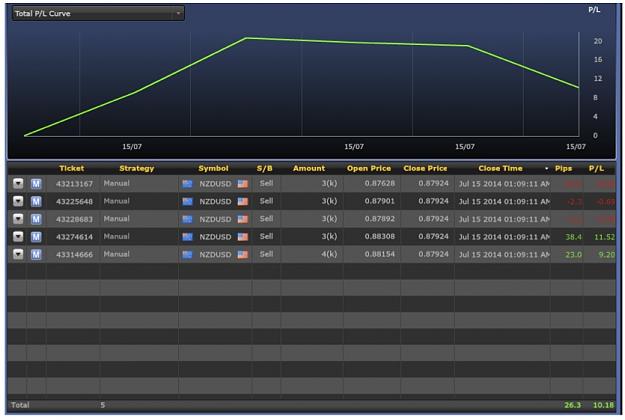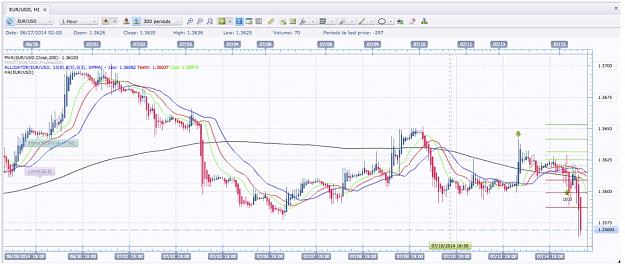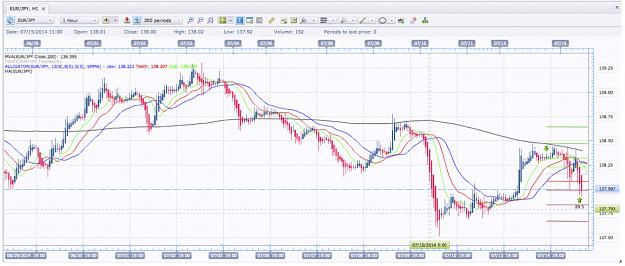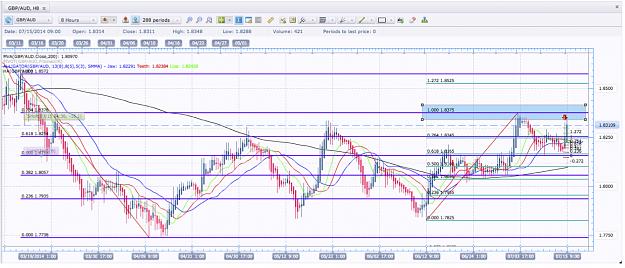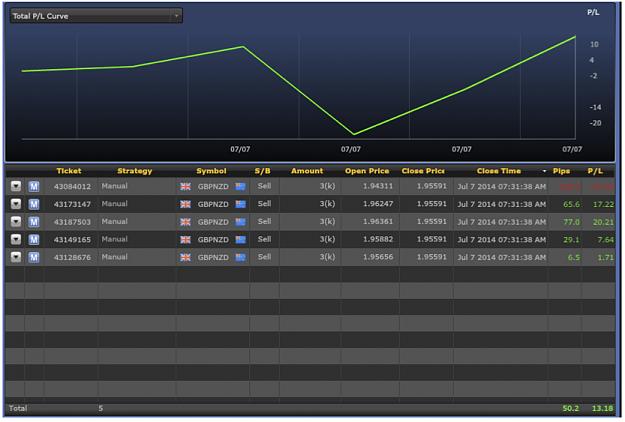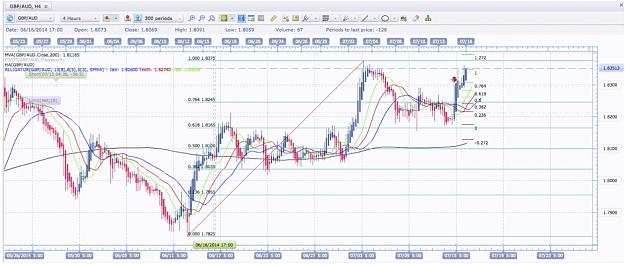So, I figured I'd take some time to outline my basic pivot point trading method guidelines, which is what I use on a daily basis to take advantage of intraday price swings between pivot points.
For several months, I have posted about this method on DailyFx's Trading Journal forum. Originally, the intent of my journal was to evaluate and test the Mirror Trader Platform's "free" automated strategies to see whether a method of choosing and using the strategies could be developed that would be profitable, save me time, and, quite honestly, whether they were worth anything, given the fact that they were "free."
Much to my chagrin, I was unable to be consistently successful using the suite of strategies they have available, having been frequently aggravated by some of the trading decisions made by the strategies I'd set up to run. To be completely fair, however, I virtually abandoned trading using the Mirror Trading strategies within a month of carefully picking, implementing, and then managing the chosen strategies, primarily due to the fact that (1) I am a control freak; (2) virtually learned nothing of value looking at the trades the strategies took, since their methodology was not transparent and was not always readily apparent from looking at the charts; and (3) I was at a loss as to why certain strategies would pass on a 50 pip gain, only to let a trade slip into and stop out in the red, eventually ascertaining that these strategies were -- to use a baseball analogy -- batting for the wall when all I wanted to do was hit well placed ground balls to get to first base. I simply am not the kind of trader who can tolerate or wait for a strategist to strike it big on one 2-1 risk/reward plus trade to offset their slow torture of my equity in the mean time, especially in these low volatility markets where one has to inevitably settle for less.
I also think that, as a trading community, Forex Factory tends to be a little bit more active than DailyFx, since I imagine that the vast majority of users there are due to their being associated with one broker, FXCM, while here there are folks you use a wide number of brokers, so I figured I'd start a thread here instead.
In any event, ...
As with any method, I tweak these rules or guidelines from from time to time or exercise common sense and discretion with individual trades. I know that this method may violate several cardinal rules. However, the method tells me when to enter; when to exit; can be done with a minimum of time before the New York and Asian sessions; gets me in and out of trades in fairly short order; and frees me from paralysis by analysis. I refer to the method as "dollar cost averaging," since, in essence, you are buying a pair with a lot size that remains constant intra-trade for the cost of that fixed size lot at the time it is purchased.
Does it, for example, on occasion have large intratrade drawdowns? Certainly. Do you add positions to what traditional traders would label "bad" trades? Yes. Is failing to use stop losses crazy? Yes, to some, it is insanity; however, one of the hallmarks of the system is the virtually miniscule position sizes as compared to what I've seen traders using. Naturally, if you're going to use 10 x equity (10%) of your margin per leg of the trade, you're going to quickly run into trouble with doing things this way, and you'd best move along. But I assume you, like me, are also tired of having your trades stopped out, only to have price move in the direction of your original trade and then to your TP in short order. Again, I'm not batting for the wall; I'm trying to make singles ... . Stops get in the way of the relatively small movements I want to take advantage of intraday and jack up an otherwise good trading choice when the only thing that is lacking is the preciseness of my timing as to entry.
In a nutshell:
The basic set-up is a 1H chart with the following indicators: Fib Retracement Pivot Points (Daily) and 200 SMA. You can also use an RSI, other MA's or indicators to assist you in your decision-making process as to the direction your trade should take. If you platform doesn't have Fib Retracement Pivot Points, you can also use Classic or Camarilla pivot points as guidelines for entries and TP's.
Small lot entries/small lot positions: .25-.5 times equity for each entry. For example, if you have $10,000 worth of equity, your lot sizes should be between 2 and 5K for each entry. Try to keep in mind that you may want to add to a given position if the TP is not hit immediately and where the set-up remains valid. Where possible, keep the total size of any position to <1 times equity. What is of primary importance to me is that, under no circumstances do I want to get near having a margin call, with the destructive result being that the system shuts down positions. You may be comfortable with larger positions; this size suits me, at least for now.
My routine is to first check what's on tap on the econ calendar, focusing primarily on medium or high level reports; generally, low level reports don't move the market much. I generally want to avoid pairs that are most likely to be affected by a given report.
I then start scrolling through the charts shortly after the New York close (as this is when "new" daily pivot points are formed), generally looking for 200 SMA's with fairly flat aspects, price action that moves back and forth across the SMA, or price that is hugging the SMA. I may also look at how the RSI is behaving in attempt to validate the direction I think I should go. Additionally, I will also just look at price action for swing highs and lows and see how well those levels have been respected. In other words, I am generally looking for pairs that are range-bound, at least for the short term. Additionally, I will use multi-time frame analysis to examine how the pair's price is doing with respect to the 200 period MA. Generally speaking, if price is below the 200 SMA on the 1 and 6H time frames, I will look to fashion an entry order to sell; if it is above, I look to fashion a buy.
Also, I may look at even higher time frames (8H, Daily) to see if the pair is in a discernible range, short term or otherwise. Naturally, if it is ranging, but in a wider range, I may opt to wait until price moves more to the top or bottom of the range to consider a trade.
For buys: entry order at .236, TP at .764. For sells, entry at .764, TP and .236. I virtually never set an SL, unless it is ensure profit or avoid loss after price has moved into profit.
Where a position opens and the TP is not reached by the close of the following day, reset the TP to the new levels established by the newly formed pivot points and, assuming the set-up is still valid, create appropriate entry orders to add to the position in the direction of the original trade if it makes sense (again, sells at the .764, buys at the .236). If the resetting of a TP to the new pivot point would result in a loss, I generally set the TP to at least a 10 pip gain.
If the order for the additional leg executes, adjust the TP to the greater of the appropriate pivot point or 10 pips, whichever is greater.
Use common sense to avoid situations such as doubling up on currencies or closely correlated pairs, onerous swaps that will cut into your profit, and pairs that just aren't worth wading into due to the narrow range in which they're trading. For example: (1) if you've got one Yen long cross, leave it at that. There is little point going long with CHF/JPY and EUR/JPY; they're basically the same thing. Doing that can amplify your gains, but can set you up for multiple "dog" trades that you have to gracefully exit, rather than just one. Look for other set-up's with other currencies. They're virtually always out there. (2) Right now NZD short has an onerous swap. Since you can't be absolutely certain that you'll be able to exit that before incurring a negative swap, it is best to avoid NZD shorts for the time being. Look for NZD long set-up's going forward. (3) There are several currency pairs whose movement is glacial and not worth bothering with. For example, and against my better judgment, I entered into a EUR/CHF trade earlier today that only had a potential range between the .736 and .234 of less than five pips. The pair ran through my range, and I gained some pips (2.7 to be exact), but really, are you that desperate? (well, I guess I was, because I took the trade).
* * *
I would note that I frequently violate a couple common rules regarding risk management and risk/reward ratio with this method. First of all, I almost always do not apply stops. However, the lot sizes are so small that I would have to endure a 200 pip spike for me to begin to feel the pain. Use common sense; if you've added to a position thinking that your set-up is still valid and your position is approaching 1 times equity, place some kind of reasonable stop if that is what you need not to have a heart attack. Secondly, while the risk-reward ratio sometimes starts out pretty good (from .236 to .764 is a pretty good gain with most pairs), this ratio will narrow if the pivot box contracts due to less volatility or the pair moves against you. Again, though, you're looking for singles; not home runs.
You may, on some occasions, want to let certain trades run. If that is the case, however, you want to at least consider taking some of the meat off the table at the .764, 1, or 1.272 (in the case of a buy), and placing a stop in such a way that you are trading with house money at that point.
As with all things, some patience is required. In my case, I examine the charts, place the entry orders, and then try not to look at the charts again until the following morning or evening. The movement of certain pairs, after all, can be maddening in the short-term either because they're moving at a glacial pace (EUR/CHF) or because they seem to be bouncing all over the place (GBP/JPY). There's no point in staring at the screen; it won't help the price move in the direction you want. Believe me, I've tried. Moreover, quite frequently, you may have to hold a position longer than you'd like. Ideally, you'd like to be out of positions by the weekend so that you can sit back and relax without having to think about that "dog" trade you made that is weighing you down, but that's not always possible. Sometimes, you may have wait for the right moments to add a leg or legs to the position to allow you to exit the net position profitably; don't panic, pairs are in ranges 70% of the time and sometimes all it takes to be successful with a net position is time and for the pair to fall back into a range or begin consolidating.
* * *
Lastly, it is unfortunate that I am a Mac user and don't use Metatrader, which I have found to be unstable. Consequently, I can't set up a Trade Explorer (at least right now, the techies here have told me), which would save me tons of time. I will try to post examples of trades and results here on a regular basis. I am not here to pump a system or to advocate a particular way of doing things. This is just an idea you can look at and consider, along with the apparent gajillion other ideas posted out there on the web. Also, this is not the only tool I use in my toolbox; there are plenty of trade set-up's out there that I look at that involve somewhat intricate charting and examining the precise point at which I am going to consider a buy or sell and that may require several weeks of waiting for the set-up's to develop. This is just what I use on a day-to-day basis.
Regardless of whatever system you use, happy trading! (Or, at least, heart attack free trading).
Mike, The ZebraSquirl
For several months, I have posted about this method on DailyFx's Trading Journal forum. Originally, the intent of my journal was to evaluate and test the Mirror Trader Platform's "free" automated strategies to see whether a method of choosing and using the strategies could be developed that would be profitable, save me time, and, quite honestly, whether they were worth anything, given the fact that they were "free."
Much to my chagrin, I was unable to be consistently successful using the suite of strategies they have available, having been frequently aggravated by some of the trading decisions made by the strategies I'd set up to run. To be completely fair, however, I virtually abandoned trading using the Mirror Trading strategies within a month of carefully picking, implementing, and then managing the chosen strategies, primarily due to the fact that (1) I am a control freak; (2) virtually learned nothing of value looking at the trades the strategies took, since their methodology was not transparent and was not always readily apparent from looking at the charts; and (3) I was at a loss as to why certain strategies would pass on a 50 pip gain, only to let a trade slip into and stop out in the red, eventually ascertaining that these strategies were -- to use a baseball analogy -- batting for the wall when all I wanted to do was hit well placed ground balls to get to first base. I simply am not the kind of trader who can tolerate or wait for a strategist to strike it big on one 2-1 risk/reward plus trade to offset their slow torture of my equity in the mean time, especially in these low volatility markets where one has to inevitably settle for less.
I also think that, as a trading community, Forex Factory tends to be a little bit more active than DailyFx, since I imagine that the vast majority of users there are due to their being associated with one broker, FXCM, while here there are folks you use a wide number of brokers, so I figured I'd start a thread here instead.
In any event, ...
As with any method, I tweak these rules or guidelines from from time to time or exercise common sense and discretion with individual trades. I know that this method may violate several cardinal rules. However, the method tells me when to enter; when to exit; can be done with a minimum of time before the New York and Asian sessions; gets me in and out of trades in fairly short order; and frees me from paralysis by analysis. I refer to the method as "dollar cost averaging," since, in essence, you are buying a pair with a lot size that remains constant intra-trade for the cost of that fixed size lot at the time it is purchased.
Does it, for example, on occasion have large intratrade drawdowns? Certainly. Do you add positions to what traditional traders would label "bad" trades? Yes. Is failing to use stop losses crazy? Yes, to some, it is insanity; however, one of the hallmarks of the system is the virtually miniscule position sizes as compared to what I've seen traders using. Naturally, if you're going to use 10 x equity (10%) of your margin per leg of the trade, you're going to quickly run into trouble with doing things this way, and you'd best move along. But I assume you, like me, are also tired of having your trades stopped out, only to have price move in the direction of your original trade and then to your TP in short order. Again, I'm not batting for the wall; I'm trying to make singles ... . Stops get in the way of the relatively small movements I want to take advantage of intraday and jack up an otherwise good trading choice when the only thing that is lacking is the preciseness of my timing as to entry.
In a nutshell:
The basic set-up is a 1H chart with the following indicators: Fib Retracement Pivot Points (Daily) and 200 SMA. You can also use an RSI, other MA's or indicators to assist you in your decision-making process as to the direction your trade should take. If you platform doesn't have Fib Retracement Pivot Points, you can also use Classic or Camarilla pivot points as guidelines for entries and TP's.
Small lot entries/small lot positions: .25-.5 times equity for each entry. For example, if you have $10,000 worth of equity, your lot sizes should be between 2 and 5K for each entry. Try to keep in mind that you may want to add to a given position if the TP is not hit immediately and where the set-up remains valid. Where possible, keep the total size of any position to <1 times equity. What is of primary importance to me is that, under no circumstances do I want to get near having a margin call, with the destructive result being that the system shuts down positions. You may be comfortable with larger positions; this size suits me, at least for now.
My routine is to first check what's on tap on the econ calendar, focusing primarily on medium or high level reports; generally, low level reports don't move the market much. I generally want to avoid pairs that are most likely to be affected by a given report.
I then start scrolling through the charts shortly after the New York close (as this is when "new" daily pivot points are formed), generally looking for 200 SMA's with fairly flat aspects, price action that moves back and forth across the SMA, or price that is hugging the SMA. I may also look at how the RSI is behaving in attempt to validate the direction I think I should go. Additionally, I will also just look at price action for swing highs and lows and see how well those levels have been respected. In other words, I am generally looking for pairs that are range-bound, at least for the short term. Additionally, I will use multi-time frame analysis to examine how the pair's price is doing with respect to the 200 period MA. Generally speaking, if price is below the 200 SMA on the 1 and 6H time frames, I will look to fashion an entry order to sell; if it is above, I look to fashion a buy.
Also, I may look at even higher time frames (8H, Daily) to see if the pair is in a discernible range, short term or otherwise. Naturally, if it is ranging, but in a wider range, I may opt to wait until price moves more to the top or bottom of the range to consider a trade.
For buys: entry order at .236, TP at .764. For sells, entry at .764, TP and .236. I virtually never set an SL, unless it is ensure profit or avoid loss after price has moved into profit.
Where a position opens and the TP is not reached by the close of the following day, reset the TP to the new levels established by the newly formed pivot points and, assuming the set-up is still valid, create appropriate entry orders to add to the position in the direction of the original trade if it makes sense (again, sells at the .764, buys at the .236). If the resetting of a TP to the new pivot point would result in a loss, I generally set the TP to at least a 10 pip gain.
If the order for the additional leg executes, adjust the TP to the greater of the appropriate pivot point or 10 pips, whichever is greater.
Use common sense to avoid situations such as doubling up on currencies or closely correlated pairs, onerous swaps that will cut into your profit, and pairs that just aren't worth wading into due to the narrow range in which they're trading. For example: (1) if you've got one Yen long cross, leave it at that. There is little point going long with CHF/JPY and EUR/JPY; they're basically the same thing. Doing that can amplify your gains, but can set you up for multiple "dog" trades that you have to gracefully exit, rather than just one. Look for other set-up's with other currencies. They're virtually always out there. (2) Right now NZD short has an onerous swap. Since you can't be absolutely certain that you'll be able to exit that before incurring a negative swap, it is best to avoid NZD shorts for the time being. Look for NZD long set-up's going forward. (3) There are several currency pairs whose movement is glacial and not worth bothering with. For example, and against my better judgment, I entered into a EUR/CHF trade earlier today that only had a potential range between the .736 and .234 of less than five pips. The pair ran through my range, and I gained some pips (2.7 to be exact), but really, are you that desperate? (well, I guess I was, because I took the trade).
* * *
I would note that I frequently violate a couple common rules regarding risk management and risk/reward ratio with this method. First of all, I almost always do not apply stops. However, the lot sizes are so small that I would have to endure a 200 pip spike for me to begin to feel the pain. Use common sense; if you've added to a position thinking that your set-up is still valid and your position is approaching 1 times equity, place some kind of reasonable stop if that is what you need not to have a heart attack. Secondly, while the risk-reward ratio sometimes starts out pretty good (from .236 to .764 is a pretty good gain with most pairs), this ratio will narrow if the pivot box contracts due to less volatility or the pair moves against you. Again, though, you're looking for singles; not home runs.
You may, on some occasions, want to let certain trades run. If that is the case, however, you want to at least consider taking some of the meat off the table at the .764, 1, or 1.272 (in the case of a buy), and placing a stop in such a way that you are trading with house money at that point.
As with all things, some patience is required. In my case, I examine the charts, place the entry orders, and then try not to look at the charts again until the following morning or evening. The movement of certain pairs, after all, can be maddening in the short-term either because they're moving at a glacial pace (EUR/CHF) or because they seem to be bouncing all over the place (GBP/JPY). There's no point in staring at the screen; it won't help the price move in the direction you want. Believe me, I've tried. Moreover, quite frequently, you may have to hold a position longer than you'd like. Ideally, you'd like to be out of positions by the weekend so that you can sit back and relax without having to think about that "dog" trade you made that is weighing you down, but that's not always possible. Sometimes, you may have wait for the right moments to add a leg or legs to the position to allow you to exit the net position profitably; don't panic, pairs are in ranges 70% of the time and sometimes all it takes to be successful with a net position is time and for the pair to fall back into a range or begin consolidating.
* * *
Lastly, it is unfortunate that I am a Mac user and don't use Metatrader, which I have found to be unstable. Consequently, I can't set up a Trade Explorer (at least right now, the techies here have told me), which would save me tons of time. I will try to post examples of trades and results here on a regular basis. I am not here to pump a system or to advocate a particular way of doing things. This is just an idea you can look at and consider, along with the apparent gajillion other ideas posted out there on the web. Also, this is not the only tool I use in my toolbox; there are plenty of trade set-up's out there that I look at that involve somewhat intricate charting and examining the precise point at which I am going to consider a buy or sell and that may require several weeks of waiting for the set-up's to develop. This is just what I use on a day-to-day basis.
Regardless of whatever system you use, happy trading! (Or, at least, heart attack free trading).
Mike, The ZebraSquirl
Fireworks are fun ... as long as you don't blow your fingers off.
